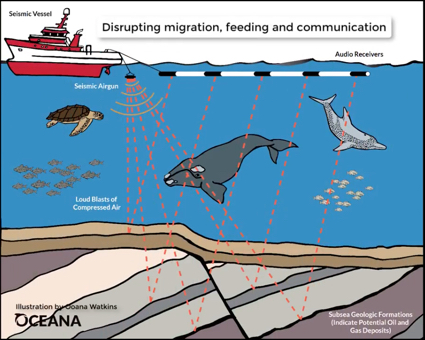Written by Kylie West
When we consider major environmental threats to marine life, we often think of issues such as oil spills, overfishing, and plastic pollution. A threat that’s likely not as familiar to the general public but holds grave consequences is that of ocean noise pollution. NOAA’s National Ocean Service defines ocean noise pollution as “sounds made by human activities that can interfere with or obscure the ability of marine animals to hear natural sounds in the ocean.” An article in Yale Environment 360 shares a quote from marine scientist Christopher Clark: “We are injecting so much noise that we are effectively acoustically bleaching the world’s oceans.”
Until about 100 years ago, the only sounds of the ocean were natural: either abiotic sounds of the earth, weather, and sea, or the biological sounds necessary for the communication of sea-dwelling organisms. The development of fossil-fuel driven vessels and their associated technologies, however, has resulted in a much wider range of noises from human activities such as industrial shipping, military sonar, and seismic surveys. Scientists are conducting research as they attempt to determine the impact that these sounds have on wildlife. Ocean Conservation Research (OCR) is an organization that focuses on the effects of industrialization and noise pollution on marine life and seeks solutions to reduce its impact on the sea. “The sea is 10 times louder now that it was just fifty years ago due to international shipping and the mechanization of ocean enterprises,” OCR Director Michael Stocker says.
Anthropogenic noise in the ocean is concerning not only for the stress it brings to marine life but also for its interference with animals’ ability to communicate with one another and perceive critical sounds such as approaching predators, the contact sounds of conspecifics, and even the sounds of their own food sources. Ocean noise pollution even has the potential to cause physiological damage to animals’ auditory systems.
Disturbing anthropogenic noise has a particularly powerful effect on cetaceans. The onslaught of noise not only interferes with their ability to use echolocation to communicate with one another but also has a significant impact on their behavior. Seismic surveys, used for oil exploration, create the loudest noises produced in the ocean and can be particularly disruptive to whales. A series of bubble blasts is generated from the sound, which can be heard hundreds to thousands of miles away underwater. Clark states, “…there are entire sections of the ocean — 100,000-square-mile areas at a time — that are awash in this sound and where whales just leave the area or shut up completely. We noticed them trying to hide behind rocks to escape in a sound shadow…some of the gray whales actually came right into the surf — we could see their bodies in the breaking waves — to try to get away from this.”
“We noticed them trying to hide behind rocks to escape in a sound shadow…some of the gray whales actually came right into the surf — we could see their bodies in the breaking waves — to try to get away from this.”
Human-generated noise generated by pile driving, a construction activity used in, among other things, the construction of wind farms, also impacts whales. Minke whales’ behavior has been altered by these noises as far as 40 km from a pile driving location, according to a study published in the International Journal of Environmental Research and Public Health. This same study revealed that the strandings of Cuvier’s beaked whale, Blainville’s beaked whale, and Gervais’ beaked whale often occurred after the reported onset of sounds from international naval exercises. Investigation divulged that the whales had suffered severe diffuse congestion and hemorrhage, possibly from altered behavioral responses to ocean noise.
solutionS
Not enough is understood or known at this time to fully address the increasing threat that anthropogenic noise poses to individual and collective marine life. However, as scientists gain ground through research, monitoring, and new technologies, and as the public becomes better informed and active on the issue, the stress effects of human-generated sound on marine wildlife can begin to be managed.
Fortunately, work is being done to design quieter ships. For example, Maersk Line, the world’s largest container shipping company, modified a number of their container vessels in 2015 and 2016. Five of the ships were selected to compare the underwater radiated noise before and after radical retrofits and found that the noise was indeed reduced. The study is available for reading here. Additionally, large ships in Vancouver were asked to slow down in Haro Strait. The report shared that reducing vessel speeds is an effective way of reducing the generated underwater noise.
The most important thing you can do to help is speak up. Ocean noise pollution may not be visible as plastic pollution is, but its potential for destruction is devastating to marine life and has been overlooked for too long. Education and effort by all, including lawmakers, is needed to mitigate the challenge.
“That’s what whales do; they give the ocean its voice, and the voice they give it is ethereal and unearthly.”


